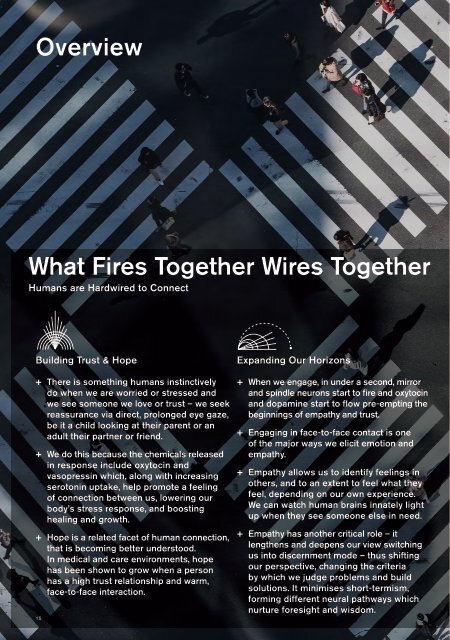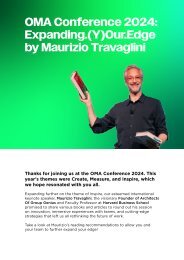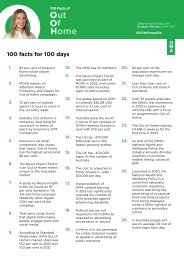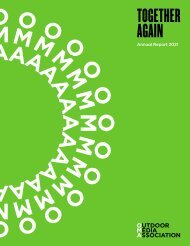THE ART AND SCIENCE OF LOOKING UP REPORT
Create successful ePaper yourself
Turn your PDF publications into a flip-book with our unique Google optimized e-Paper software.
Overview<br />
What Fires Together Wires Together<br />
Humans are Hardwired to Connect<br />
Building Trust & Hope<br />
Expanding Our Horizons<br />
Firing & Wiring Together<br />
Being Human<br />
+ There is something humans instinctively<br />
do when we are worried or stressed and<br />
we see someone we love or trust – we seek<br />
reassurance via direct, prolonged eye gaze,<br />
be it a child looking at their parent or an<br />
adult their partner or friend.<br />
+ We do this because the chemicals released<br />
in response include oxytocin and<br />
vasopressin which, along with increasing<br />
serotonin uptake, help promote a feeling<br />
of connection between us, lowering our<br />
body’s stress response, and boosting<br />
healing and growth.<br />
+ Hope is a related facet of human connection,<br />
that is becoming better understood.<br />
In medical and care environments, hope<br />
has been shown to grow when a person<br />
has a high trust relationship and warm,<br />
face-to-face interaction.<br />
15<br />
+ When we engage, in under a second, mirror<br />
and spindle neurons start to fire and oxytocin<br />
and dopamine start to flow pre-empting the<br />
beginnings of empathy and trust.<br />
+ Engaging in face-to-face contact is one<br />
of the major ways we elicit emotion and<br />
empathy.<br />
+ Empathy allows us to identify feelings in<br />
others, and to an extent to feel what they<br />
feel, depending on our own experience.<br />
We can watch human brains innately light<br />
up when they see someone else in need.<br />
+ Empathy has another critical role – it<br />
lengthens and deepens our view switching<br />
us into discernment mode – thus shifting<br />
our perspective, changing the criteria<br />
by which we judge problems and build<br />
solutions. It minimises short-termism,<br />
forming different neural pathways which<br />
nurture foresight and wisdom.<br />
+ When we look up, directly interact and<br />
lock eyes we are connecting physically<br />
with each other’s brains and bodies –<br />
synchronising and resonating with each<br />
other electrochemically.<br />
+ The more we get to know each other,<br />
the stronger that synchronisation is and<br />
the shorter the lag time between sender<br />
and receiver as we tune in our radar.<br />
+ We can also synchronise at scale, with a<br />
contagion effect that can be wonderful in a<br />
trusting and positive environment as it can<br />
lead to building shared neural networks<br />
of possibility. In a negative environment it<br />
also changes us, but not for the better.<br />
+ As a result, a group of connected people<br />
can change how we see an issue, alter our<br />
priorities as a group, and create a capacity<br />
to collaborate around shared values.<br />
+ Real live connections and interactions<br />
are at the very heart of what makes<br />
us human. It is what we are hardwired for.<br />
+ A strong sense of our surroundings<br />
and real human connection can give us<br />
a greater sense of identity and a feeling<br />
and experience of belonging, both of<br />
which are fundamental to trust and a<br />
sense of hope.<br />
+ Looking up and out to engage directly<br />
with the world around us, and who<br />
we share it with, unlocks a cascade<br />
of resultant neurological effects and<br />
measurable chemical and physiological<br />
changes that profoundly influence our<br />
bodies, our behaviour, our capacity to<br />
make decisions – the very nature of our<br />
humanity. It is critical to our individual<br />
mental and physical wellbeing, and in turn,<br />
our societies’ health and life together.<br />
16















